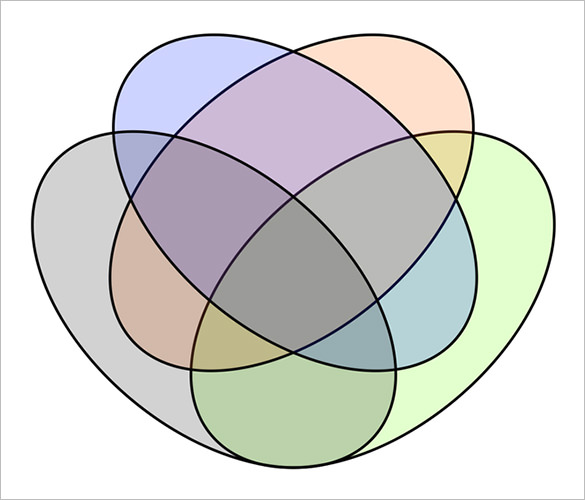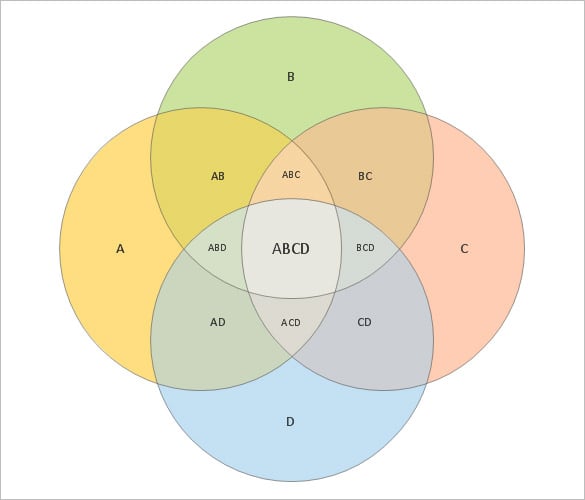All of us have seen a Venn diagram. They were created by John Venn in 1880, and that's pretty much all of the history behind them. Sorry. We've also all probably dealt with a three way Venn diagram. Scandalous! But within the four-way diagram, controversy! It's possible you've seen the kind pictured on the right, but this is actually not a four way Venn diagram. There's sections missing, like AC and BD. The true four-way Venn diagram looks like the one below it. Beautiful.

Now a rather forced transition into my point, political spectrums. The standard political spectrum is a horizontal line punctuated with various groups which fall on a certain point between communism and fascism. Rather like the incorrect diagram, this doesn't really comprise individuals who fall between parties for some reason or another, forcing them to chose a side or be forgotten.
Political spectrums, at their core, are just ways to simplify an extremely complex political system. The problem with these over simplifications is that the real-life landscape of politics becomes shaped by them. The U.S. is very divided these days, and I can't help but think that some of that is due to the way these models are presented. As I mentioned earlier, I worry that overly simplified models can inspire an attitude of competition, one party against the other, rather than the air of compromise our country was built on.
Factions are important in our country, but representing them incorrectly as football teams rather than negotiators is incredibly harmful.

Very interesting post! I completely agree with your point that it's unfair to over-simplify the political spectrums as it overrides citizens who might be caught in between sides for a variety of reasons or beliefs. In addition, the mention that these spectrums may contribute to the current divide throughout the country was very insightful, as many may place themselves on one side or the other, creating rivaling teams rather than compromising groups.
ReplyDeleteI agree with what you're saying. While there are people on both extremes, most of Americans lay somewhere in the middle. That being said, the country seems to be moving towards more polarization with the political groups and ideologies. This could be a result of what you have brought up. The over simplification of theses spectrums can reinforce the idea of its one side or the other despite the vast majority of people being a mix of both sides,
ReplyDeleteI agree with what you are saying, that these oversimplified political systems water down the complexity of the actual political systems. However it's important to understand while the oversimplification isn't necessarily the best representation, it gives people a basic understanding of the political systems. But by looking at the overcomplicated one, it can construe misguided notions about political systems or even cause political ignorance. In addition, the oversimplified version might not stick to, or is only somewhat accurate.
ReplyDeleteI definitely agree with this and I really like how you incorporated the four group venn diagram with it. The only thing is, the simplified version is a way for people to immediately understand who the person is and what they believe in. While this may not be the most accurate representation, I feel like many people will get very confused with this accurate representation. I definitely think that it should be an option for people because it will show every aspect of someone and their beliefs, however, I think that the simplified versions should also be available. Personally, I know that if I saw the accurate venn diagram, I probably would not understand any of it and I would actually get more out of the simple one.
ReplyDeleteThis is an incredibly important post!! I agree with the way that the models present competition and a more divided society. I think it's important to show all different sides because when all groups are represented in politics, it's easier to unite and see all sides instead of just the usual main groups. Many people are affected by this competition because they're probably also more drawn to shape their political views to fit a specific norm.
ReplyDeleteYour point that oversimplifying the political spectrum can cause more polarization and division within the United States is interesting in light of the recent reading (Section 11.6 from the 2012 election edition of the textbook American Government: Roots and Reform, which is by Karen O'Connor, Larry J. Sabato, and Alixandra B. Yanus). This part of the textbook mentioned that although political beliefs espoused by the Democratic and Republican party are severely polarized today, most Americans identify as moderate and do not subscribe themselves strongly to one party. This could be a result of the oversimplification of the political spectrum you talk about since Americans cannot identify with any of the extreme and stark differences between groups displayed in a political spectrum. This can possibly be harmful to American democracy because it can cause people to not feel attached to politics and to potentially feel apathetic to voting and politics completely.
ReplyDelete